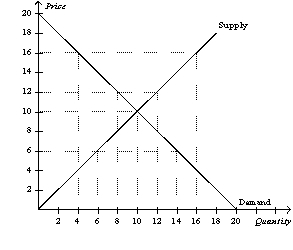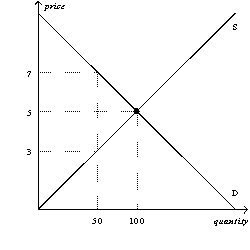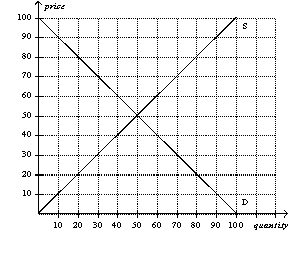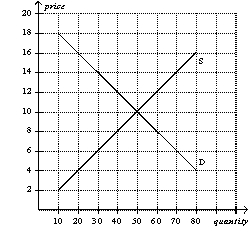A) a middle-class standard of living.
B) employment.
C) a minimally adequate standard of living.
D) unemployment compensation.
F) A) and B)
Correct Answer

verified
Correct Answer
verified
Multiple Choice
Figure 6-4
 -Refer to Figure 6-4.A government-imposed price of $6 in this market is an example of a
-Refer to Figure 6-4.A government-imposed price of $6 in this market is an example of a
A) binding price ceiling that creates a shortage.
B) non-binding price ceiling that creates a shortage.
C) binding price floor that creates a surplus.
D) non-binding price floor that creates a surplus.
F) B) and C)
Correct Answer

verified
Correct Answer
verified
Multiple Choice
Figure 6-3
 -Refer to Figure 6-3.A binding price floor is shown in
-Refer to Figure 6-3.A binding price floor is shown in
A) both panel (a) and panel (b) .
B) panel (a) only.
C) panel (b) only.
D) neither panel (a) nor panel (b) .
F) None of the above
Correct Answer

verified
Correct Answer
verified
Multiple Choice
Figure 6-15
 -Refer to Figure 6-15.Suppose a tax of $2 per unit is imposed on this market.How much will buyers pay per unit after the tax is imposed?
-Refer to Figure 6-15.Suppose a tax of $2 per unit is imposed on this market.How much will buyers pay per unit after the tax is imposed?
A) $3
B) between $3 and $5
C) between $5 and $7
D) $7
F) All of the above
Correct Answer

verified
Correct Answer
verified
True/False
States in the U.S.may mandate minimum wages above the federal level.
B) False
Correct Answer

verified
Correct Answer
verified
True/False
Economists argue that rent control is a highly efficient way to help the poor raise their standard of living.
B) False
Correct Answer

verified
Correct Answer
verified
Multiple Choice
Which of the following is correct?
A) Rent control and the minimum wage are both examples of price ceilings.
B) Rent control is an example of a price ceiling, and the minimum wage is an example of a price floor.
C) Rent control is an example of a price floor, and the minimum wage is an example of a price ceiling.
D) Rent control and the minimum wage are both examples of price floors.
F) All of the above
Correct Answer

verified
Correct Answer
verified
Multiple Choice
Table 6-1
 -Refer to Table 6-1.Which of the following price floors would be binding in this market?
-Refer to Table 6-1.Which of the following price floors would be binding in this market?
A) $1
B) $2
C) $3
D) $4
F) A) and C)
Correct Answer

verified
Correct Answer
verified
Multiple Choice
When a binding price floor is imposed on a market to benefit sellers,
A) every seller in the market benefits.
B) all buyers and sellers benefit.
C) every seller who wants to sell the good will be able to do so, but only if he appeals to the personal biases of the buyers.
D) some sellers will not be able to sell any amount of the good.
F) C) and D)
Correct Answer

verified
Correct Answer
verified
Multiple Choice
Which of the following is the most likely explanation for the imposition of a price ceiling on the market for milk?
A) Policymakers have studied the effects of the price ceiling carefully, and they recognize that the price ceiling is advantageous for society as a whole.
B) Buyers of milk, recognizing that the price ceiling is good for them, have pressured policymakers into imposing the price ceiling.
C) Sellers of milk, recognizing that the price ceiling is good for them, have pressured policymakers into imposing the price ceiling.
D) Buyers and sellers of milk have agreed that the price ceiling is good for both of them and have therefore pressured policymakers into imposing the price ceiling.
F) B) and D)
Correct Answer

verified
Correct Answer
verified
True/False
Figure 6-26
 -Refer to Figure 6-26.A price floor set at $40 would create a surplus of 20 units.
-Refer to Figure 6-26.A price floor set at $40 would create a surplus of 20 units.
B) False
Correct Answer

verified
Correct Answer
verified
True/False
Price ceilings are typically imposed to benefit sellers.
B) False
Correct Answer

verified
Correct Answer
verified
Multiple Choice
The mayor of Workerville proposes a local payroll tax to fund a new water park for the city.The mayor proposes to collect half the tax from workers and half the tax from firms.The mayor will be able to successfully divide the burden of the tax equally if the
A) demand for labor is more elastic than the supply of labor.
B) supply of labor is more elastic than the demand for labor.
C) demand for labor and supply of labor are equally elastic.
D) It is not possible for the tax burden to fall equally on firms and workers.
F) A) and D)
Correct Answer

verified
Correct Answer
verified
True/False
When policymakers set prices by legal decree,they obscure the signals that normally guide the allocation of society's resources.
B) False
Correct Answer

verified
Correct Answer
verified
Multiple Choice
Figure 6-25
 -Refer to Figure 6-25.In which market will the tax burden be most equally divided between buyers and sellers?
-Refer to Figure 6-25.In which market will the tax burden be most equally divided between buyers and sellers?
A) market (a)
B) market (b)
C) market (c)
D) All of the above are correct.
F) B) and C)
Correct Answer

verified
Correct Answer
verified
Multiple Choice
Suppose that the demand for digital cameras is elastic,and the supply of digital cameras is inelastic.A tax of $20 per camera levied on digital cameras will decrease the effective price received by sellers of digital cameras by
A) less than $10.
B) $10.
C) between $10 and $20.
D) $20.
F) C) and D)
Correct Answer

verified
Correct Answer
verified
Multiple Choice
An outcome that can result from either a price ceiling or a price floor is
A) a surplus in the market.
B) a shortage in the market.
C) a nonbinding price control.
D) long lines of frustrated buyers.
F) A) and D)
Correct Answer

verified
Correct Answer
verified
Multiple Choice
Figure 6-4
 -Refer to Figure 6-4.A government-imposed price of $12 in this market is an example of a
-Refer to Figure 6-4.A government-imposed price of $12 in this market is an example of a
A) binding price ceiling that creates a shortage.
B) non-binding price ceiling that creates a shortage.
C) binding price floor that creates a surplus.
D) non-binding price floor that creates a surplus.
F) All of the above
Correct Answer

verified
Correct Answer
verified
Multiple Choice
Figure 6-6
 -Refer to Figure 6-6.If the government imposes a price ceiling of $12 on this market,then there will be
-Refer to Figure 6-6.If the government imposes a price ceiling of $12 on this market,then there will be
A) no shortage.
B) a shortage of 10 units.
C) a shortage of 20 units.
D) a shortage of 40 units.
F) A) and C)
Correct Answer

verified
Correct Answer
verified
True/False
Since half of the FICA tax is paid by firms and the other half is paid by workers,the burden of the tax must fall equally on firms and workers.
B) False
Correct Answer

verified
Correct Answer
verified
Showing 101 - 120 of 557
Related Exams